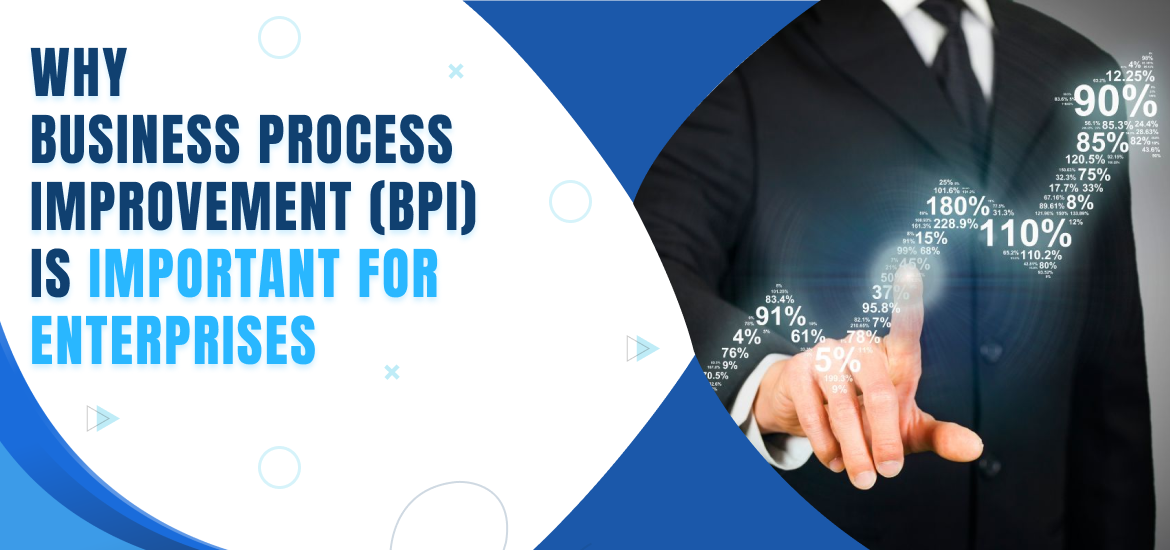
Business Process Improvement
Why Business Process Improvement (BPI) Is Important For Enterprises
Oct 30th, 2025
For modern businesses, continuous improvement isn’t optional; it’s essential. You can’t just survive, you have to thrive. The market shifts faster than ever, so how your work gets done is crucial. This focus is called Business Process Improvement (BPI). It’s the engine that pushes your organization forward. BPI moves you from simple daily management to achieving strategic growth and excellent performance.
For a business owner, a decision-maker, or a project manager, the prime goal should be to eliminate waste, speed up delivery, and raise quality across the board. BPI gives you the structure to hit these targets. It’s a methodical way to analyze, redesign, and implement changes. It ensures your processes are efficient, effective, and always ready to adapt.
Why Process Improvement is an Enterprise Necessity, Not an Option
The competitive landscape demands speed. Customers expect personalized experiences. We are dealing with sheer data volume. Processes from a few years ago are now slow. They are often fragmented and wasteful. Sticking to “the way we’ve always done it” guarantees stagnation.

The Clear Financial Upside of BPI
BPI initiatives may sound abstract. However, their impact on your bottom line is very concrete. Current data clearly supports this point:
- Significant ROI: Companies doing Business Process Management (BPM) projects see a high return. BPM is the umbrella strategy that includes BPI. Roughly 80% of these organizations report an internal ROI higher than 15%. This solid return comes directly from cost savings and increased revenue.
- Productivity Boost: Organizations focusing on BPI enjoy major productivity gains. Processes for back-office staff can achieve 30% to 50% productivity increases. Knowledge workers often see increases of 15% to 30%.
- Reduced Errors and Waste: Automation plays a key role in BPI. It can reduce manual errors by nearly 50%. It also increases task completion speed by over 40%. For an enterprise, fewer errors mean less rework. This results in lower costs and better product or service quality.
The Manufacturing Shift: Case Study
Take the example of a global manufacturing company. They used BPI to overhaul their complex supply chain and inventory management completely. First, they used process mapping. This visualized every step, from raw material purchase to final product delivery. This effort revealed massive bottlenecks. These were mostly in their manual approval and data entry systems.
Next, they acted. They automated key data transfer and approval stages. They used specialized software solutions for this. The results were dramatic: they saved billions of hours. How? By automating 64% of their manufacturing tasks. They drastically cut inventory holding costs. They also greatly improved their just-in-time delivery accuracy. This directly enhanced customer satisfaction and boosted their market agility.
The Pillars of a Robust BPI Strategy
For BPI to truly work, it must target key areas. These benefits are what drive enterprise success:
1. Efficiency and Waste Reduction
This is BPI’s most visible benefit. Business Process Improvement is fundamentally about stripping away waste. It removes anything that doesn’t add value for the customer. Think of Lean principles or the 5 Whys. You ask why a step exists until you find the root inefficiency.
- Eliminate Bottlenecks: Manual data entry, unnecessary approvals, or long waiting periods create bottlenecks. Streamlining these steps compresses the cycle time. This applies to everything from order fulfillment to client onboarding.
- Standardization: BPI creates consistent, documented workflows. When everyone follows the same optimized steps, the outcome is predictable. Quality remains high. This eliminates relying on one person’s “heroic effort” or specialized knowledge.
2. Enhanced Customer Experience (CX)
Slow internal processes always mean poor customer service. If your sales-to-onboarding process takes three weeks, your new client is already frustrated. This usually happens due to manual handoffs between departments.
- Faster Service Delivery: Make internal processes quicker and more accurate. You can then respond to customer inquiries faster. You can deliver products or services more reliably.
- Consistency is Trust: BPI ensures consistent quality in every customer interaction. This is true regardless of the employee or department involved. This reliability builds customer trust and loyalty.
3. Regulatory Compliance and Risk Reduction
In regulated industries, processes must be auditable and compliant. Fragmented, manual processes are a regulatory nightmare.
- Built-in Controls: BPI embeds required sign-offs and compliance checks directly into the workflow. In the finance sector, for example, an optimized process ensures every transaction is automatically logged and reviewed. This reduces the risk of fraud or non-compliance penalties.
- Data Integrity: BPI reduces manual data transfer. Errors are common in manual transfer. Therefore, BPI improves data accuracy. This is vital for accurate reporting and risk assessment. Organizations lose millions annually due to bad data.
4. Employee Satisfaction and Empowerment
Employees hate repetitive, low-value tasks like manual data entry. Spending days on them crushes morale and focus. Employees often waste up to 50% of their day on these menial data management tasks.
- Focus on Value: BPI identifies and eliminates these repetitive tasks. This is often done through automation. It frees up your skilled workers. They can then focus on strategic, creative, and customer-facing work. They can finally use their real expertise.
- Clarity and Accountability: Clear processes use a centralized system. This ensures everyone knows their job. They know who is responsible for the next step and what the goal is. This clarity cuts down on confusion and stress.
Also Read – 8 Proven Factors Affecting Employee Productivity at Work
The Essential Role of Office Management Software in Driving Business Process Improvement
A BPI strategy is only as strong as its execution. This is where modern software becomes vital. Integrated solutions, like Task Management Software and Project Management Software, are essential tools. They are indispensable for both the process manager and the enterprise.
Task Management Software: The Micro-Engine of BPI
BPI is about the actual work—the tasks that form the process. A task management solution provides the real-time, ground-level engine. It handles both process execution and monitoring.
- Standardizing Individual Tasks: A BPI plan might redesign your invoice approval. Software like TaskOPad ensures every step is clear. Each task (e.g., “Review for Accuracy,” “Final Approval”) gets assigned. It has a deadline. This standardizes how the process is executed across your entire organization.
- Visibility and Accountability: The software gives a seamless, audit-ready trail. You track a task from one person to the next. Managers see instantly who has the task. They know how long it’s taking. They spot current bottlenecks. This visibility is key to continuous improvement. You can’t fix what you can’t see.
- Enforcing the New Process: Once you improve a process, the task management system enforces the new, optimal steps. It stops employees from returning to old, inefficient habits.
Project Management Software: Orchestrating the Change
Task management runs the improved process day-to-day. Project management software is a vital tool for managing the BPI initiative itself.
- The BPI Project Life Cycle: BPI is a series of projects. These include mapping the current state, designing the future, implementing changes, and measuring results. A project management platform offers the tools you need. It handles scheduling, resource allocation, and milestone tracking for the BPI team.
- Strategic Alignment: The software always ties BPI efforts to your main business goals. A project to automate support workflow, for instance, links directly to “improving Customer Satisfaction by 20%.”
- Data-Driven Decisions: The system collects data on the new process’s speed and efficiency. This data is analyzed in the project management environment. Project managers measure the real impact of the change. They can show, for example, that the time-to-close for a support ticket dropped from 48 hours to 8. This creates the feedback loop for ongoing improvement.
For decision-makers, robust tools connect strategy and reality. A platform that combines task management and project management, like TaskOPad, is powerful. It lets you run your daily operations efficiently. It also lets you manage the large-scale improvement projects that redefine your business.
Also Read – 5 Steps to Optimize Task Management Process For Better Productivity
Making Business Process Improvement a Continuous Culture
Business Process Improvement is not just a quick clean-up. It’s a fundamental mindset. It’s a continuous cycle. This involves constant review, analysis, and optimization.
Modern enterprises need an agile approach internally. Market conditions change constantly. Technology evolves quickly. Think of the rising role of GenAI in process automation. Customer demands shift fast. Therefore, your processes must be flexible enough to adapt.
Here is a shocking fact: Only 1% of firms fully control their business processes. They fail to realize the full financial benefits of digital transformation. This highlights a clear need. You need a sustained, systematic focus on improvement.
Successful BPI needs several key ingredients. It requires leadership commitment and demands cross-functional collaboration. You must have the right digital tools, like TaskOad, to empower staff. These tools ensure accountability. They provide the real-time data needed for the cycle to keep turning. Book your free demo now and see how you can achieve greater profitability, lower risk, and a stronger, more resilient enterprise.
Search by posts
Search by posts
Recent posts
11-30-2025
Project Team Management
7 Essential Steps for Running a Successful Project Kickoff Meeting
11-29-2025
Team Communication













